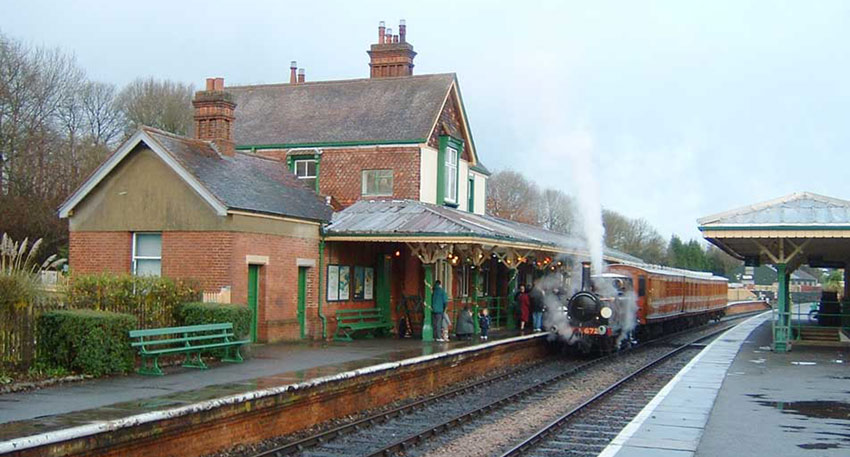History of Kingscote Station
For two decades the northern terminus of the Bluebell Railway, which has been lovingly and carefully restored since we purchased it in January 1985. The second platform, demolished by a former owner, has been rebuilt complete with a signal-box and a replica of the original canopy.
The station has been restored to its 1950s condition by “The Friends of Kingscote”, a volunteer group within the Society, who now maintain the station.
With Sheffield Park having become home to our locomotive works, loco shed, offices, restaurant and main shop, and Horsted Keynes similarly developed as our carriage restoration base, Kingscote is the only chance the railway has to retain the sleepy atmosphere of the historic line. Now the extension to East Grinstead is completed, this is all the more so; the quiet spot where the visitor to the line can escape the crowds on a busy day.
To encourage people to stop off here, we have a children’s outdoor play area behind platform 2, and we are starting to develop a representation a typical country station goods yard, appropriate to the station’s own history.
History of Kingscote Station
Station Staff
We are fortunate to be able to share with you some views and memories from the early 1920s of Kingscote station.
Our collection of photographs of the staff working here during this period are copies of those taken by Leonard (Len) Mead, son of the Kingscote Stationmaster at the time. Len developed and printed these photographs in a makeshift darkroom in the cupboard under the stairs of the station house. He visited the station with his sister during its restoration in 1987 and continued to visit until his death in 1993. His ashes lie under an apple tree planted in his memory in the station garden.
Len is shown here at Kingscote in a contemporary view. As he scratched his name across the back of the negative, the photo was printed in reverse. He is, in reality, standing at the south end of the up platform, with the up home signal and the chimneys of the railway cottages in the background.
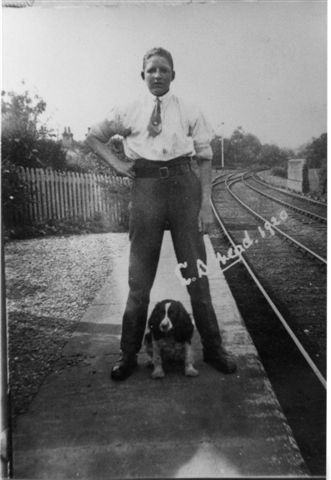
The Station Master
William George May Mead (Len’s father) moved to Kingscote from Hever in 1915. He had started in the signal box at Clapham Junction and moved on to Victoria where he became Chief Clerk. He first became station master at Wivelsfield and his next post was at Hever. After his tenure at Kingscote, Mr Mead went on to Emsworth (near Portsmouth) and finished his career at the Parcels Office at Brighton.
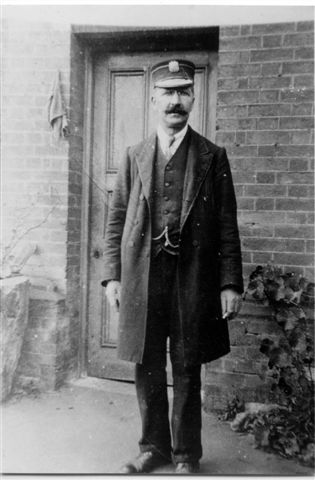
A Stationmaster was a man worthy of respect in the community, expected to set an example to passengers and staff. He therefore wears full uniform. Note the heavy boots worn even by the Stationmaster and the chain for a pocket watch. In the 1920s wristwatches were rare and expensive, and unsuitable in manual industries such as railways. The informality possible at a quiet station like Kingscote is perhaps shown by the cigarette Mr Mead has not quite hidden in his hand while he has his photograph taken.
Mr Mead was the last Stationmaster, since when he moved on in 1926 Kingscote came under the control East Grinstead, an early foretaste of future economies.
The booking clerk
Charlie Browning stands by the Station porch at Kingscote. The stained glass panels and carved pilasters did not stand up well to the Sussex weather and were replaced by wooden boarding at all stations on the line. Clerks were not issued with a uniform.
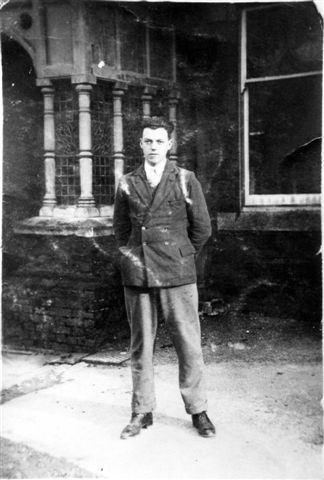
Charlie had started at West Hoathly but, according to Len, had not ‘settled down’ there. Stationmaster Mead saved the situation by having him moved to Kingscote under closer supervision. Charlie stayed on the railway until his retirement circa 1970 from his position as Assistant Chief Clerk in the booking office at Brighton.
Charlie Browning is shown in this view, captioned by Len as a “learner clerk”. He is doubtless wearing what the smart young man of the 1920’s was wearing at the time!
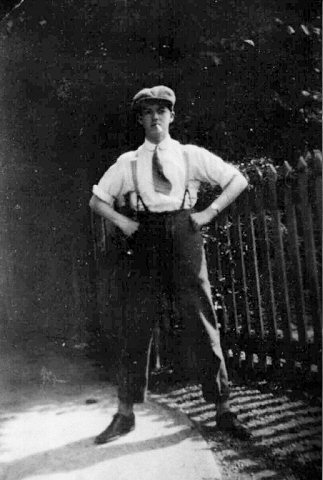
We originally believed the location to be at the south end of the up platform, but now (due to the presence of the large plant pot and the return in the fence) we consider that it is outside the entrance to the station house.
Alfred James Hillman, Porter–Signalman
Alfred lodged with the Mead family in the station house; his own family (father, James and mother, Nellie) lived at 13 Highlands, Cuckfield. Families frequently took in a paying lodger who was often treated, as Alfred was, like one of the family. Alfred (born 1899) befriended the younger Len Mead (born 1900) and appears in two further photographs.
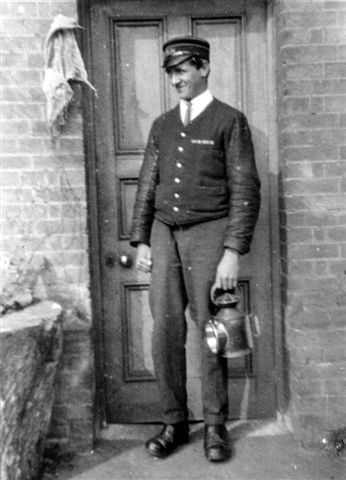
Porter Signalman was a job common at small stations when the infrequent train service did not warrant either a full-time signalman or a porter. It was a stepping-stone between the general labouring duties of a porter and the more responsible position of full-time signalman at a busier station. Alfred later moved on to become signalman at Arundel Junction.
Alfred wears the regulation ‘sleeved waistcoat’ supplied to railway staff until the 1970s. He carries a paraffin-lit handlamp which was used to give signals to a guard or driver at night; it could show white, red or green by turning the top to bring coloured glass between the flame and the lens. He is standing in front of the door to the Porters’ Room Room. The section of tree trunk at the left was for chopping kindling wood on. The rag hanging on the nail was to wipe one’s hands on, as there was no running water in the Porters’ Room – water having to be brought from the pumphouse in a bucket or churn.
The photo below left shows Alfred on the steps of Kingscote signalbox at the northern end of platform two. The sawmill and its rail connections can be seen in the background.
Below right, Alfred proudly displays his First World War medal ribbons. One is the the British War Medal 1914–1918 (the campaign medal); another is the Allied Victory Medal, while the third is the Military Medal (a gallantry medal), awarded to him in 1918 for ‘Bravery in the Field’ during his service on the Western Front in France or Belgium in the 6th Battalion, West Yorkshire Regiment. He had been conscripted on 26th November 1917 (conscription having been introduced in 1916) and was discharged on 16th March 1919. Conscripts were often sent to regiments with little apparent connection with their home.
Len Mead told us that the Military Medal was awarded for Alfred’s actions in covering a retreat by firing his Lewis (machine) gun until the ammunition was used up and only then ‘running like hell’ after his comrades! The photograph was taken only a few years after the end of what was then called the ‘Great War’ – in which nearly 750,000 young British men had died and many more been maimed, gassed or mentally injured by ‘shell shock’.
Note Alfred’s ‘LB&SCR Porter’ cap badge, with number to identify the member of staff.
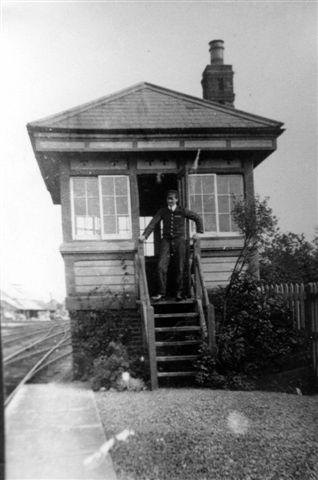
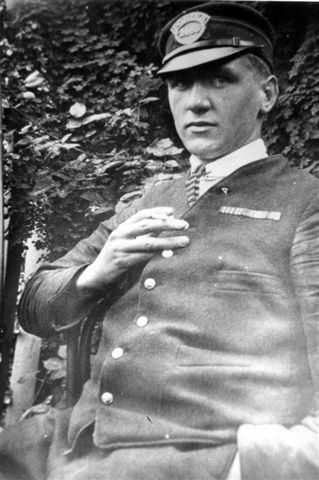
William Parker, Porter–Signalman
William was another Porter Signalman like Alfred Hillman.
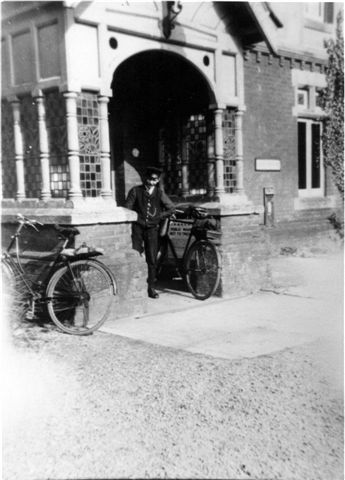
Born in 1886, he started his railway career in 1910 at Barnham Junction, moving to Kingscote five years later. He originally lived in one of the pair of station cottages (located in the lane just south of the station) but moved into the station house when Stationmaster Mead and his family moved away in 1926. He soon also took on the duties of booking clerk as the station’s trade no longer justified a separate clerk. William Parker retired in October 1951, after 36 years in the same job at the same location.
William Thorpe, Porter–Signalman
William (Bill) Thorpe was a Porter Signalman (according to Len’s caption) “in the last few years at Kingscote”. We know very little about him, except that he moved on to Angmering station as a Signalman and was known to be there between 1947 and 1960. Bill is shown, probably once again outside the entrance to the station house, wearing the contemporary uniform of the Southern Railway.
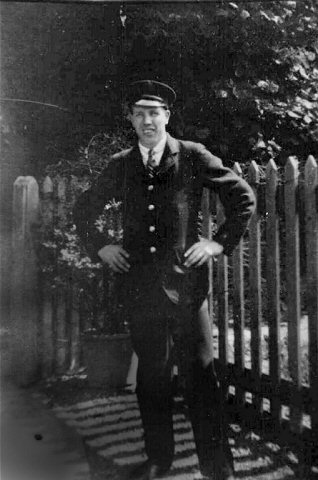
If you know of any further information on the railway career of Bill Thorpe, or any of the other staff shown in these photographs, we would be pleased to learn it.
The Ganger
‘Pedlar’ Miles was the ‘Ganger’ responsible for the ‘gang’ of men who maintained the track at Kingscote and for a mile or two either side. Short in stature, his stride was not long enough to comfortably step from one sleeper to the next when walking his ‘length’ of track each morning. His solution was to walk on the top of the rail with a stick to balance him. He lived in the other railway cottage at Kingscote, next to William Parker. He is shown standing in front of the door to the station coal store.
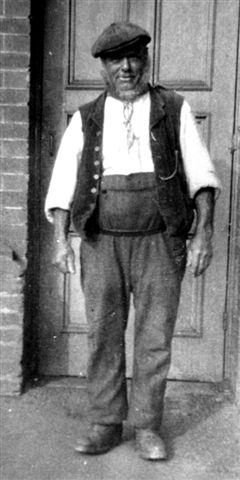
The Odd Shot
Len’s caption for this view reads: “The picture just shows the end of the Goods Shed. The man in the photo was the (6ft 4ins tall) son of the Stationmaster at Dormans station. Just a pal of mine.”
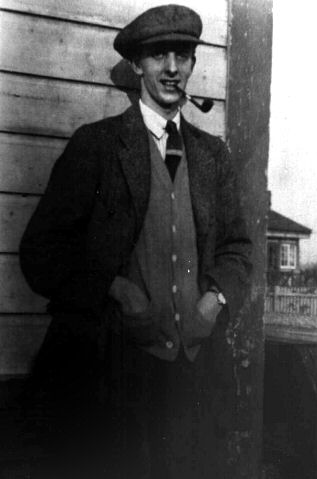
We do not know the name of the man, but 6ft 4ins was extremely tall for the 1920s. If you know of any further information on him, we would be pleased to learn it. Other items of note in this view are the end of the original signalbox and the roses trailing through the paling fence of the up platform.
Station area
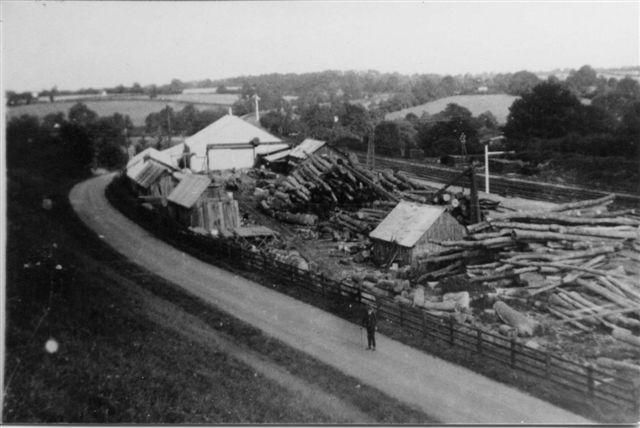
The timber yard and sawmill north of the station provided both incoming and outgoing goods traffic, but all the main contracts went out by rail. The machinery included both hand and mechanical saws. There was a shed which contained a pit saw worked by a man at each end cutting vertically, one man standing in the specially built lower well area. On Saturday mornings Len would earn a bit of extra pocket money by reporting to Harry Gasson, the Foreman at the mill, to wheel away barrow loads of saw dust.
Here the yard has been caught when stocks of raw materials were high. Such extreme neatness was commonly seen at industrial locations of this time when labour was cheap and handling machinery rare.
The shed shown in this view still stands today, albeit reclad in modern materials.
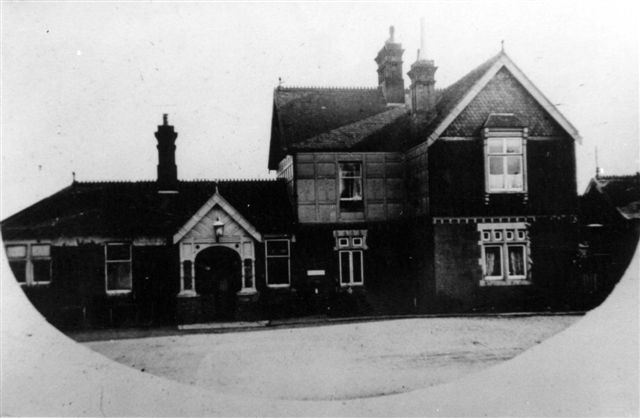
The above view of the station building from the forecourt shows the floral decoration and half timbering that was originally a feature of the upper storey of all the station buildings on the line. Poor weather resistance may have been the problem responsible for its subsequent elimination. Here, half of it is shown covered by hanging tiles. The remainder would be replaced or covered by cement rendering by the Southern Railway.
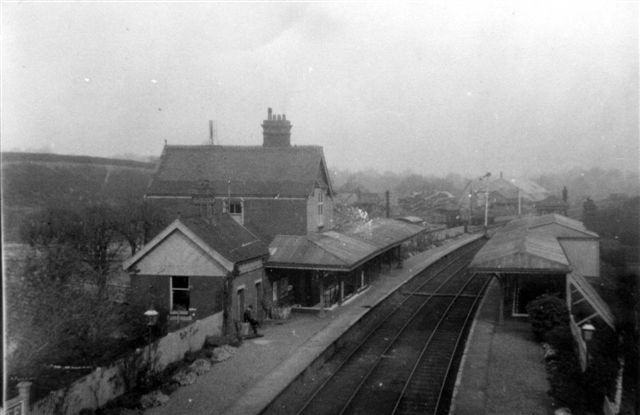
This view, taken from the tall wooden signal that stood at the south end of the down (No 2) platform, shows well the gentle 39 chain (280 metre) radius curve of the track through the station. Note the heavy timber buttresses necessary to stop the buildings sliding down the slope. This must have been a quiet moment at Kingscote judging by the member of staff apparently asleep in the sun outside the Porters’ Room.
© Roger Barton and Martin Skrzetuszewski, September 2004.
With thanks for past assistance from Klaus Marx and Robin White.
Recommended reading:
An Illustrated History of the Lewes & East Grinstead Railway by Klaus Marx, published by Oxford Publishing Company, 2000 (ISBN 0860935477) contains ten pages of text on and photographs of Kingscote station.
Kingscote in the 1950s
A taste of life in 1953 at Kingscote
The Station Master in charge of Kingscote is located at East Grinstead, the station being run by Porter-Signalmen. These are Porters who spend less than 50% of their time in the signal box. They sell tickets and deal with the few parcels in the ticket office, see the few trains safely away from the platforms, keep the station clean and the flower beds tidy, deal with goods paperwork in the ticket office and help to shunt wagons around in the yard. The basic working week is 40 hours, comprising 5 rostered 8-hour turns between Monday and Saturday. The sixth turn or “rest day” may be worked at overtime rate if there is no “rest day relief” man. Sunday is always a rest day. Pay has just risen from £5.16.9 (£5.83) per week.
Kingscote Porter-Signalman Ernie Marshall lives in the station house with his wife Marjorie. They have lived there since William Parker moved out following his retirement in 1951 and they will be the last BR tenants. Rent for the station house is in the region of 15 shillings (75p) a week.
The first trains of the day are the 6.43 to Brighton and the 7.29 to East Grinstead. The last trains are the 9.1 pm to East Grinstead and the 9.20 pm to Haywards Heath. A later train to East Grinstead passes Kingscote, but is not booked to stop.
There are annual Best Kept Station Awards, which are presented (for the Redhill District) during the following year. Kingscote won an Additional Prize for 1952, while Sheffield Park won Second Prize in Class E.
Austerity is still very much the reality of Britain. People eat a healthy, although basic diet. Meat, bacon, butter, cheese, margarine and cooking fats are still rationed, eight years after the end of the Second World War. Tea came off ration in 1952 and this year, eggs, cream and sweets came off – just in time for the Coronation – with sugar in September. The most popular sweets are Spangles and Polo, each “tuppence” or “thruppence” a pack and Bounty chocolate/coconut bars.

Meat is still subject to rationing; the weekly meat ration allowance having increased by one penny, to one shilling and ninepence (9p). Bacon and ham are rationed separately; about 4 ounces in total a week per person being allowed. Consequently, country people still keep chickens for eggs and meat. Pigeons are shot for food. Wild rabbits are also hunted for food. They are usually shot, snared or “rooted out” by a terrier dog or ferret. However, care must be exercised when selecting a wild rabbit, as there is an outbreak of myxomatosis, first discovered near Edenbridge (Kent) this autumn.
Few people have a refrigerator, relying on cool larders (like the one off the station house kitchen) and gauze-covered “meat safes”. Many homes, including the station house, have no electricity yet. Most food is bought fresh so shopping can be undertaken almost daily. Blocks of ice cream can be bought at sweet shops that have an electric freezer. It is wrapped in newspaper to insulate it for the journey home, but must be eaten within a couple of hours. At the seaside, fairs or carnivals etc., individual ice creams between wafers or in cornets can be bought from the man on his tricycle. This has an insulated box containing “dry ice” (solid carbon-dioxide) in which the ice-creams are carried.
Money is short and the wartime philosophies still endure, so people grow most of their own vegetables and fruit. Typical garden-grown vegetables are cabbages, carrots, broad beans, peas, potatoes, runner beans and marrows. Apple or pear trees, raspberry canes, blackcurrant bushes and rhubarb may also be found in country gardens. People regularly pick wild blackberries when in season. The station house and railway cottages have gardens in which their tenants can grow some food, but many folk have an additional “allotment”, like the one at the south end of the gardens of the railway cottages. This allotment boasts some old quince trees. The fruit of these trees can be used to make quince jelly, the fore-runner of orange marmalade. During the War, housewives were encouraged to “preserve” fruit by home canning or bottling in special jars.
There are old apple and pear trees in the station house garden. When the fruit is in season, it can be exchanged with engine crews for some coal off the locomotive. Coal is used to fire the cast-iron cooking “range” in the kitchen (examples of modern versions being the Aga and Rayburn), the clothes washing “copper” in the scullery or to fuel the open fires in the other four rooms.
Gas is produced from coal and its supply is generally restricted to urban areas near the gasworks. There is a gasworks in East Grinstead but no pipes are laid in this direction.
There is no mains water at Kingscote yet. Most houses in the area have or share a well. The station’s water supply (from its well behind the down platform) has been shown to be now unfit for drinking, but still satisfactory for washing. Drinking water is delivered to the station by train in small galvanised churns. You can see these standing on the up platform in the photo below.
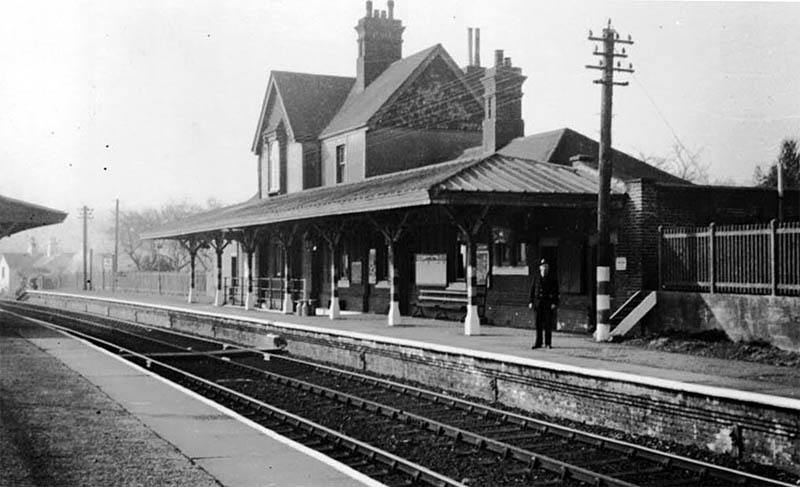
This view of the up platform was taken by Mr. G S Robinson on 1st. April 1955. We do not have the name of the member of station staff in attendance although it could well be Ernie Marshall. Note that the wartime white striping (applied to reduce accidents during the night-time “blackout” when the station platforms would have been in total darkness) is still quite clear on the canopy columns and telegraph pole. Signal bell codes and telephony were carried along bare copper wires suspended from these poles on insulators. Note the wooden steps (again, painted white) to gain quick access to the goods dock and also the porters’ board crossing between platforms.
There is a ready supply of lamp oil (for the signal lamps, station and platform lighting) in the station Lamp Room. One of the Porter-Signalman’s duties is to light the lamps at dusk, extinguish them in the morning, refill the tanks and trim or replace the wicks.
Ordinary people still walk fair distances in the country although most have bicycles. Motor cars are a common sight, but most people do not own one. One of the modern family motorcars on sale is the Morris Oxford (similar to but larger than the Minor). Public transport is important. Local people catch the train to go to the cinema in East Grinstead. They may cycle in or use a bus to go shopping. The green London Transport 473 bus runs from Horsham to Edenbridge via Turners Hill and East Grinstead. Modern London Transport single-deck, diesel-engined buses (RF or GS) operate the route and the stop is at the end of Station Road, on the main road. Most lorries are powered by petrol engines. They are not fuel efficient, are inherently slow and are additionally subject to either a 20 or 30 mph. speed limit. Some local deliveries, particularly brewers’ drays, are still horse-drawn.
King George VI, who led us through the Second World War and whose picture hangs above the ticket window in the booking hall, died in February last year. His eldest daughter, Princess Elizabeth, was crowned Queen in June in a spectacular ceremony which was transmitted live by radio to every corner of the Empire. The event overshadowed the climbing of Mount Everest by Edmund Hillary and Sherpa Tensing on 29th. May. For the first time, a Coronation was covered by the new media – television. Queen Mary, the mother of King George VI, passed away earlier this year.
Televisions are expensive. A Ferguson 998 table top set with a 12 inch screen costs 49 Guineas (£51.45). A similar 17 inch set costs 69 Guineas (£72.45) while a 17 inch floor-standing “console” set costs around £100. They can be rented but, unlike radio sets, they require mains electricity. Radios are normally powered by lead-acid cells or batteries known as “accumulators”. These have to be charged up regularly and would probably have been taken to the local bicycle shop or garage for this to be done; or perhaps one of the local farms has a petrol dynamo. For the majority of the population who did not have access to a television, a feature film “A Queen is Crowned” was made and was shown soon afterwards at local cinemas.
Among the films being shown at the cinema earlier in the year were the war film, The Cruel Sea (starring Jack Hawkins and Donald Sinden) and comedy, The Titfield Thunderbolt (starring Stanley Holloway, George Relph and John Gregson). Summer saw the release of the popular comedy, Genevieve (starring John Gregson, Dinah Sheridan, Kenneth More and Kay Kendall).
Some homes may have a (clockwork) gramophone, which you need to wind up with a removable handle in the side. The circular 78 r.p.m. records are not that cheap but are growing in popularity. The New Musical Express introduced a “Top 12” record sales chart last year. This year, two of the most memorable records at “number one” are “I Believe” by Frankie Laine and “Don’t Let The Stars Get In Your Eyes” by Perry Como, although “(How Much Is That) Doggy In The Window” by Lita Roza was number one for one week in April.
The radio is used sparingly, but many wives insist on listening to the 15-minute episode of “The Archers” every weekday evening on the Light Programme. There is an hour-long “Sports Report” at 5 p.m. on Saturday evenings during the football season. Children listen to “Children’s Favourites” on Saturday morning with Uncle Mac. Billy Cotton’s Band Show is regular listening on Sunday afternoon. The news can be heard on the Home Service where there are five broadcasts a day, but some people in the country rely on a neighbour or friend passing on the previous day’s newspaper to keep them abreast of happenings further afield.
In June, Blackpool won the FA (Football Association) Cup; the team including a 38-year old Stanley Matthews. In August, England beat Australia at cricket to win the Ashes – the first time since 1932.

Tragically, on the night of 31st. January, over three hundred people were killed during floods in Essex, Norfolk and Lincolnshire, and the ferry “Princess Victoria” was lost in the Irish Sea. Even more (over 1800) died on the same night in Holland.
During the year Welsh poet Dylan Thomas passed away, as did also Django Reinhardt, the jazz guitarist and Hank Williams, the American “country music” singer.
John Christie was hanged in July at Pentonville prison, for the murder by strangling of his wife and six other women at his home in Notting Hill, London.
Around the world, Josef Stalin, the wartime leader of the USSR died in March. He has been succeeded by Nikita Krushchev. Britain has recognised the Republic of Egypt under General Naguib.
Many families have more than just a passing interest in what is going on round the world. Young men between the ages of 18 and 26 are still required to undertake two years of National Service. The army is presently involved in combating Mau-Mau terrorism in Kenya and troops have just been sent to British Guiana. Fortunately, in Korea (where British troops formed part of the United Nations army fighting the North Koreans from 1950) an armistice was signed on 27th. July at a place called Pan-mun-jom.
There is a little bit of local talk about the declaration in November that Piltdown Man was a hoax. In 1911, what seemed to be the remains of an early man, supposedly some 500,000 years old, were discovered near the local village of Piltdown, near Uckfield. This creature was hailed as an almost unique example of the “missing link” between the apes and man for many years. However, recent chemical tests carried out by Oxford University and the British Museum revealed that all the bones had been stained to make them appear fossilised; and that the jaw of the skull was from an orang-utan!
Not so many people have telephones, particularly in the country. It is expensive to rent the line and instrument, even if the wires have been run near to your home. In Britain, the telephone system is run by the GPO (General Post Office). There is a coin-operated call box for public use inside the booking hall of the station. However, it is unlikely that many of your friends have a telephone yet.
The post is fairly reliable (with next-day delivery to most places in Britain) and there is a post box in the front wall of the station. A network of rail “Travelling Post Offices” traverse the major routes of the network overnight. Mail to and from London, Dover (for the Continent), the West, Wales, the North and Scotland is carried and sorted on the train and dropped off en route. The Royal Mail is also carried in bags on many ordinary passenger or parcels trains during the day. Urgent messages may be sent by telegram from the post office in East Grinstead. A telegram message would be delivered to you, after receipt at the post office, by a GPO motor-cyclist.
British Railways were actively recruiting during 1952 (the advert above is from a popular magazine during that year). The railways were seen as a secure job – a job for life – but things were changing……..
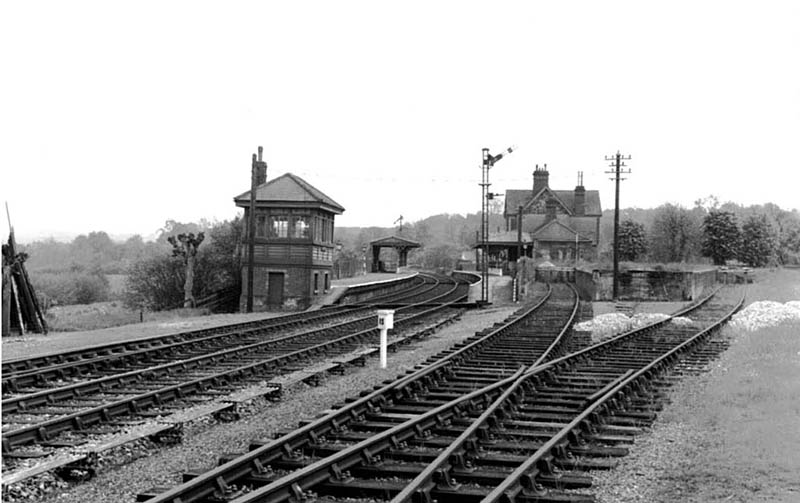
This view of the station looking in the “down” (away from London) direction was taken by Denis Cullum on 27th. May, 1955 – the day prior to closure. Note the concrete milepost (15 miles – measured from Culver Junction) and the short piece of vertical rail at the end of the platform fence. This was painted with red and white stripes and denoted the boundary point between permanent way gang’s responsibilities. A siding did once exist between the two seen here and there was an end-loading facility on the end of the goods dock. This probably existed during WW2 to assist with the unloading of tanks or other tracked vehicles, which were stored prior to “D-Day” in the woods off the road uphill from the station.
Kingscote after the trains
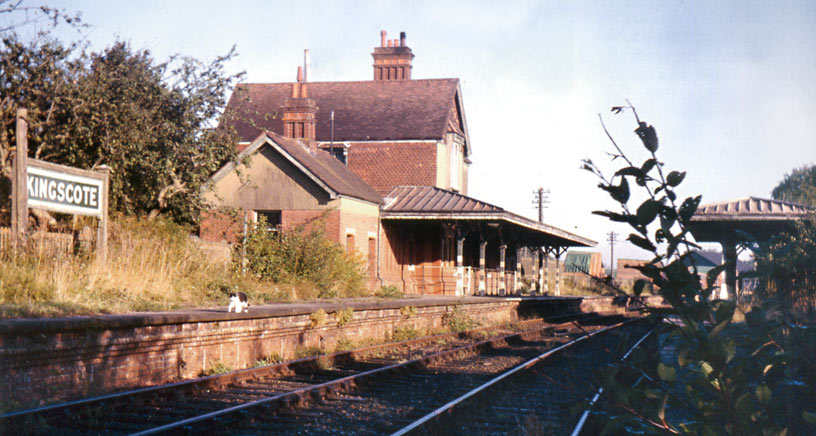
Ernest William (Ernie) Marshall (born on 27th. November 1922) continued to live in the station house until 1968 with his wife Marjorie (nee Robinson), whom he married in 1946. He was employed as a Relief Signalman at East Grinstead, but was additionally paid 7/6 (37.5p) a week to keep the signal lamps lit at Kingscote to cover any emergency workings that may have been routed over the line. Kingscote signal box, like West Hoathly, would have been closed and locked out, so that the section between East Grinstead and Horsted Keynes would have been worked (certainly latterly, when condemned wagons were stored on one running line) as a single line block.
Walking along the platform in the view above from September 1964, is the Marshalls’ cat Whisky (as in Black-and-White brand whisky). He came to a sticky end after sniffing a rabbit-hole that had earlier been gassed by the Permanent Way Department.
© Roger Barton and Martin Skrzetuszewski.
